
To help you understand what is going on in the rental and housing markets and what we expect to happen in the future, our highly experienced Kiplinger Letter team will keep you abreast of the latest developments and forecasts (Get a free issue of The Kiplinger Letter or subscribe). You'll get all the latest news first by subscribing, but we will publish many (but not all) of the forecasts a few days afterward online. Here’s the latest…
Expect growth in the rental market to keep slowing for the rest of the year after increasing just 0.3% nationally in the third quarter. Effective rents were up only 0.1%. The gap between asking and effective rents has widened, showing that some landlords are offering more free rent to entice new tenants.
Even so, rent growth is likely to be weak in the Sun Belt metro areas, which saw the fastest rising rent rates in 2021 and the first half of 2022. Now, the region has the largest imbalance of supply and demand, with record numbers of new units up for lease but too few renters. Rent growth should be stronger in Northeast and Midwest cities, particularly Jersey City (New Jersey), Cincinnati, Milwaukee, Chicago, Boston and Kansas City metro.
Apartment vacancy rates will edge up by the end of the year. Vacancies fell nationally by 5% in the third quarter, up 0.% from a year ago. The vacancy rate has risen steadily since the middle of last year, as supply now outweighs demand. Meanwhile, an influx of new apartments is hitting the market, as completions are set to rise sharply over the next year. Relatively low vacancy rates and rising rents pushed developers to move forward with multi-family projects over the past few years.
It’s possible that developers could delay some projects amid softer market conditions and take stock of the slowdown in remodeling projects. Increased prices and higher interest rates are leading homeowners to spend less. Larger projects are seeing a particular pullback, but spending on smaller jobs is slowing, too.
Similarly, the impact of higher interest rates on remodeling has been muted so far because most homeowners were still relying on savings rather than financing the project. Spending on remodeling is on track to grow around 3% this year, a far cry from the 16.3% increase in 2022. Sluggish home sales are a big reason, as remodeling and repair activity typically ramp up as owners prepare for a sale.
There are two reasons for further declines next year: a slow housing market and a cooling economy. Homeowners are likely to pull back on high-end projects and focus on necessary replacements and smaller projects. However, spending on energy-efficient retrofits may be strong in 2024 because of federal incentives.
This forecast first appeared in The Kiplinger Letter, which has been running since 1923 and is a collection of concise weekly forecasts on business and economic trends, as well as what to expect from Washington, to help you understand what’s coming up to make the most of your investments and your money. Subscribe to The Kiplinger Letter.







